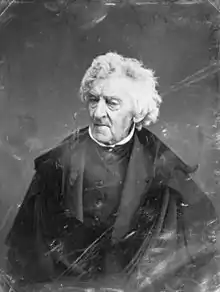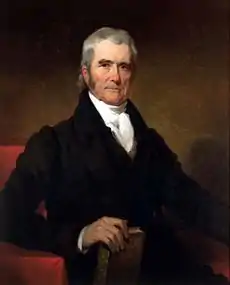William Cranch
William Cranch (July 17, 1769 – September 1, 1855) was a United States Circuit Judge and Chief United States Circuit Judge of the United States Circuit Court of the District of Columbia; the 2nd Reporter of Decisions of the Supreme Court of the United States; a Professor of law for Columbian College; and a city land commissioner for Washington, D.C.
William Cranch | |
|---|---|
 | |
| Chief Judge of the United States Circuit Court of the District of Columbia | |
| In office February 24, 1806 – September 1, 1855 | |
| Appointed by | Thomas Jefferson |
| Preceded by | William Kilty |
| Succeeded by | James Dunlop |
| Judge of the United States Circuit Court of the District of Columbia | |
| In office March 3, 1801 – February 24, 1806 | |
| Appointed by | John Adams |
| Preceded by | Seat established by 2 Stat. 103 |
| Succeeded by | Allen Bowie Duckett |
| 2nd Reporter of Decisions of the Supreme Court of the United States | |
| In office 1801–1815 | |
| Preceded by | Alexander J. Dallas |
| Succeeded by | Henry Wheaton |
| Personal details | |
| Born | William Cranch July 17, 1769 Weymouth, Province of Massachusetts Bay, British America |
| Died | September 1, 1855 (aged 86) Washington, D.C. |
| Resting place | Congressional Cemetery Washington, D.C. |
| Political party | Federalist |
| Spouse(s) | Nancy Greenleaf (m. 1795) |
| Children | 4 (including Christopher Pearse Cranch and John Cranch) |
| Parents | Richard Cranch Mary Smith |
| Relatives | William Greenleaf Eliot (son in law) Henry Ware Eliot (grandson) T. S. Eliot (great-grandson) |
| Education | Harvard University |
Education and career
Born on July 17, 1769, in Weymouth, Massachusetts,[1] Cranch graduated from Harvard University in 1787 and read law with Thomas Dawes, a relative by marriage.[1] He entered private practice in Braintree, Massachusetts in 1790.[1] He continued private practice in Haverhill, Massachusetts from 1790 to 1791.[1] He was Justice of the Peace for Essex County, Massachusetts.[1] He resumed private practice in the area ceded by Maryland that would eventually become Washington, D.C. from 1791 to 1800.[1] He was a city land commissioner for Washington, D.C. (which was officially established by the District of Columbia Organic Act of 1801 on February 27, 1801) from 1800 to 1801.[1]
Federal judicial service
Cranch was nominated by President John Adams, his uncle, on February 28, 1801, to the United States Circuit Court of the District of Columbia, to a new seat authorized by the second Judiciary Act of 1801.[1] He was confirmed by the United States Senate on March 3, 1801, and received his commission the same day.[1] His service terminated on February 24, 1806, due to his elevation to serve as Chief Judge of the same court.[1]
Cranch was nominated by President Thomas Jefferson on February 21, 1806, to the Chief Judge seat on the United States Circuit Court of the District of Columbia vacated by Chief Judge William Kilty.[1] He was confirmed by the Senate on February 24, 1806, and received his commission the same day.[1] His service terminated on September 1, 1855, due to his death in Washington, D.C.[1] He was interred in Congressional Cemetery in Washington, D.C.[2] Cranch was a member of the Federalist Party, which died out in the mid-1820s.[3] He was the last holder of a United States government office who had been a Federalist.[3]
Notable decisions
Cranch is known for several decisions that set a precedent for jury nullification (allowing a jury to nullify an "unjust" law and refuse to convict), including:
- United States v. Fenwick, 25 F. Cas. 1062; 4 Cranch C.C. 675 (1836): Right to make legal argument to jury.
- Stettinius v. United States, 22 F. Cas. 1322; 5 Cranch C.C. 573 (1839): Right to make legal argument to jury.
- Kendall v. United States ex Rel. Stokes, 37 U.S. 524 (1838): Asserted the D.C. Circuit's right to issue Writs of mandamus.[4]
Cranch also handed down important precedent in a variety of topics, for example in a criminal law case regarding the mens rea of intoxication, Cranch wrote:
It often happens that the prisoner seeks to palliate his crime by the pleas of intoxication; as if the voluntary abandonment of reason ... were not, of itself, an offense sufficient to make him responsible for all of its consequences.[5]
Other service
Concurrent with his service on the federal bench, Cranch served as the 2nd Reporter of Decisions of the Supreme Court of the United States from 1802 to 1815.[1] He also edited his own volume of reports on civil and criminal cases from the District of Columbia.[6] In 1805, Cranch became a member of the first Board of Trustees for Public Schools and served on that board for 7 years.[7] On February 3, 1826, the Columbian College (now George Washington University) board of trustees elected Cranch and William Thomas Carroll, Esq., as the first law professors. On June 13 of the same year, with President John Quincy Adams in attendance, Professor Cranch delivered the first law lecture in the court room of the City Hall.[8]
Legacy and honors
- In 1871, the Cranch Public School Building, named in Cranch's honor, opened at the southwest corner of 12th and G, SE in Washington, D.C. It was demolished in 1949.[7][9]
- Cranch was elected an Associated Fellow of the American Academy of Arts and Sciences in 1809.[10]
- Cranch was elected as a member of the American Antiquarian Society in 1813.[11]
- During the 1820s, Cranch was a member of the prestigious society, Columbian Institute for the Promotion of Arts and Sciences, who counted among their members presidents Andrew Jackson and John Quincy Adams, and many prominent men of the day, including military officers and officials of government service, and leaders of medical and other professions.[12]
Family
Cranch was the son of Richard Cranch, a cabinetmaker, and Mary Smith, the sister of Abigail Adams. Cranch married Nancy Greenleaf. They had four sons; of these, three: Christopher Pearse Cranch, Edward P. Cranch, and John Cranch, all became painters.[13] Their daughter Abigail Adams Cranch married William Greenleaf Eliot. They were the parents of Henry Ware Eliot and the grandparents of poet T. S. Eliot.
References
- William Cranch at the Biographical Directory of Federal Judges, a public domain publication of the Federal Judicial Center.
- William Cranch at Find a Grave
- Finkelman, Paul (2011). Millard Fillmore: The American Presidents Series: The 13th President, 1850-1853. New York, NY: Henry Holt and Company. p. 72. ISBN 978-0-8050-8715-4.
- Roberts, John G. (2006). "What Makes the D.C. Circuit Different?: A Historical View". Virginia Law Review. 92 (3): 375–389. ISSN 0042-6601. JSTOR 4144947.
- William Cranch, White, Edward G. 1988. The Marshall Court and Cultural Change, 1815–1835. Vols. 3 and 4, History of the Supreme Court of the United States, 1815–1835. New York: Macmillan
- Columbia), United States Circuit Court (District of; Cranch, William (July 2, 1853). "Reports of Cases Civil and Criminal in the United States Circuit Court of the District of Columbia, from 1801 to 1841". Little, Brown – via Google Books.
- Twenty-fifth Report of the Board of Trustees of Public Schools of the City of Washington, 1871-'72. M'Gill & Witherow. 1872. p. 136.
- "Probing the Law School's Past: 1821-1962". gwu.edu. Archived from the original on 17 June 2010. Retrieved 4 May 2015.
- "12th and G Street SE". The Ruined Capitol. Retrieved 21 June 2016.
- "Book of Members, 1780–2010: Chapter C" (PDF). American Academy of Arts and Sciences. Retrieved September 8, 2016.
- "MemberListC". American Antiquarian Society. Retrieved 4 May 2015.
- Rathbun, Richard (1904). The Columbian institute for the promotion of arts and sciences: A Washington Society of 1816-1838. Bulletin of the United States National Museum, October 18, 1917. Retrieved 2010-06-20.
- David Bernard Dearinger; National Academy of Design (U.S.) (2004). Paintings and Sculpture in the Collection of the National Academy of Design: 1826-1925. Hudson Hills. ISBN 978-1-55595-029-3.
Sources
| Wikimedia Commons has media related to William Cranch. |
| Wikiquote has quotations related to: William Cranch |
- William Cranch at the Biographical Directory of Federal Judges, a public domain publication of the Federal Judicial Center.
- White, Edward G. 1988. The Marshall Court and Cultural Change, 1815–1835. Vols. 3 and 4, History of the Supreme Court of the United States, 1815–1835. New York: Macmillan.
- Witt, Elder. 1990. Guide to the U.S. Supreme Court. 2d ed. Washington, D.C.: Congressional Quarterly
Further reading
- William Cranch, O Say Can You See: Early Washington, D.C., Law & Family (accessed Nov. 4, 2015) This person page networks the involvement of William Cranch in the legal records and proceedings of the Circuit Court for the District of Columbia between 1800 and 1855.
| Legal offices | ||
|---|---|---|
| Preceded by Alexander J. Dallas |
2nd Reporter of Decisions of the Supreme Court of the United States 1801–1815 |
Succeeded by Henry Wheaton |
| Preceded by Seat established by 2 Stat. 103 |
Judge of the United States Circuit Court of the District of Columbia 1801–1806 |
Succeeded by Allen Bowie Duckett |
| Preceded by William Kilty |
Chief Judge of the United States Circuit Court of the District of Columbia 1806–1855 |
Succeeded by James Dunlop |
